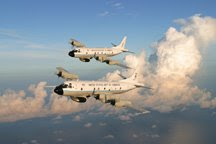 (click picture to enlarge, the your back button to return)
(click picture to enlarge, the your back button to return)Here we are nearing the end of June, and save for the short-lived Tropical Storm Arthur, the Atlantic, Caribbean and Gulf of Mexico have and continue to be quiet. That's a good thing since we are not quite ready to tackle the heart of the season.
Preparing for our annual hurricane program takes a great deal of work by members of the AOC maintenance and engineering staffs because of a number of reasons. First, gett
ing the planes physically ready to fly into the harsh environment of a hurricane means that we must perform maintenance to ensure that they are in tip-top condition. Think of it like getting your car ready for a cross-country trip. You need to put in a lot of time fixing, changing, tweaking and cleaning to be ready for the season.
The two NOAA P-3s are over 30 years old, and while they have had the best of care over their lifetimes, they have aged and require more love and tender care than ever. Comparing the engine of your car with that of the P-3, the latter is comprised of a jet engine connected to a propeller (hence the name turbo-prop) by a very complex gear box. Lot's of things can go wrong with one of these engines, and each P-3 has four of them. Above you can see a mechanic working on turbine section of one of these engines while another repairs an electrical de-icing boot on one of the propeller blades. All of this work is done at the AOC facility located at MacDill AFB in Tampa, FL. We are located in Hangar #5 on the base - the hangar shown in the movie Strategic Air Command (1955) featuring Jimmy Steward.
The Gulfstream G-IV has all of its maintenance work performed at the Gulfstream plant in Savannah, GA. This high-performance jet with its sophisticated computers and electronics requires a higher level and extent of technical expertise and equipment than can be provided at
our base in Tampa. Hence, every Spring, between winter programs and the hurricane season, it undergoes a one-month maintenance cycle in Savannah.
Another reason for the flurry of activity at this time of year relates to the extensive instrumentation installations, modifications and upgrades that usually precede the hurricane season. Different projects require different instrumentation, so when we switch from winter operations in places like Alaska or Canada, we have to spend considerable time and effort in accomplishing these changes.
We are just about finished with all of this activity, and now the waiting begins. In the meantime, the aircraft will fly some test and calibration flights, and the pilots will accomplish their mandatory annual training requirements. From here on out, this blog will be all action.
Next: Tropical Updates and Mission Plans


1 comment:
Thanks for the update Jim. I hope
the "action" from this point forward is lite and easy but for some reason I doubt that will be the case.
Harry
Post a Comment